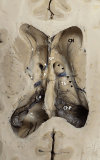Stereotactic anatomy of the third ventricle
- PMID: 38374441
- PMCID: PMC10960742
- DOI: 10.1007/s00276-024-03312-1
Stereotactic anatomy of the third ventricle
Abstract
Purpose: Endoscopic third ventriculostomy (ETV) is a surgical procedure that can lead to complications and requires detailed preoperative planning. This study aimed to provide a more accurate understanding of the anatomy of the third ventricle and the location of important structures to improve the safety and success of ETV.
Methods: We measured the stereotactic coordinates of six points of interest relative to a predefined stereotactic reference point in 23 cadaver brain hemi-sections, 200 normal brain magnetic resonance imaging (MRI) scans, and 24 hydrocephalic brain MRI scans. The measurements were statistically analyzed, and comparisons were made.
Results: We found some statistically significant differences between genders in MRIs from healthy subjects. We also found statistically significant differences between MRIs from healthy subjects and both cadaver brains and MRIs with hydrocephalus, though their magnitude is very small and not clinically relevant. Some stereotactic points were more posteriorly and inferiorly located in cadaver brains, particularly the infundibular recess and the basilar artery. It was found that all stereotactic points studied were more posteriorly located in brains with hydrocephalus.
Conclusion: The study describes periventricular structures in cadaver brains and MRI scans from healthy and hydrocephalic subjects, which can guide neurosurgeons in planning surgical approaches to the third ventricle. Overall, the study contributes to understanding ETV and provides insights for improving its safety and efficacy. The findings also support that practicing on cadaveric brains can still provide valuable information and is valid for study and training of neurosurgeons unfamiliar with the ETV technique.
Keywords: Endoscopic third ventriculostomy; Hydrocephalus; Neuroanatomy; Neuronavigation; Stereotactic coordinates; Third ventricle.
© 2024. The Author(s).
Conflict of interest statement
The authors wish to declare no conflict of interests, and no commercial relationships.
Figures



Similar articles
-
Operative planning aid for optimal endoscopic third ventriculostomy entry points in pediatric cases.Childs Nerv Syst. 2017 Feb;33(2):269-273. doi: 10.1007/s00381-016-3320-y. Epub 2017 Jan 18. Childs Nerv Syst. 2017. PMID: 28101675 Free PMC article.
-
Challenges in endoscopic third ventriculostomy for patients with achondroplasia: a focus on third ventricle floor anatomy.J Neurosurg Pediatr. 2024 Aug 30;34(5):462-469. doi: 10.3171/2024.6.PEDS2472. Print 2024 Nov 1. J Neurosurg Pediatr. 2024. PMID: 39213660
-
Transependymal Edema as a Predictor of Endoscopic Third Ventriculostomy Success in Pediatric Hydrocephalus.World Neurosurg. 2021 Dec;156:e215-e221. doi: 10.1016/j.wneu.2021.09.031. Epub 2021 Sep 21. World Neurosurg. 2021. PMID: 34560294
-
Techniques of endoscopic third ventriculostomy.Neurosurg Clin N Am. 2004 Jan;15(1):51-9. doi: 10.1016/S1042-3680(03)00066-4. Neurosurg Clin N Am. 2004. PMID: 15062403 Review.
-
Endoscopic third ventriculostomy for hydrocephalus in a patient with achondroplasia: a case report and literature review.Childs Nerv Syst. 2021 Dec;37(12):3907-3911. doi: 10.1007/s00381-021-05129-4. Epub 2021 Mar 29. Childs Nerv Syst. 2021. PMID: 33779806 Review.
Cited by
-
Stria Terminalis: An intraoperative image.Brain Spine. 2024 Nov 23;4:104144. doi: 10.1016/j.bas.2024.104144. eCollection 2024. Brain Spine. 2024. PMID: 39669718 Free PMC article. No abstract available.
-
Optimal trajectory of the neuroendoscope for third ventricle pavement access.Front Neuroanat. 2025 Jan 22;19:1431128. doi: 10.3389/fnana.2025.1431128. eCollection 2025. Front Neuroanat. 2025. PMID: 39911564 Free PMC article.
References
-
- Decq P. Pediatric hydrocephalus. 2. Milano: Springer; 2005. Endoscopic anatomy of the ventricles; pp. 351–359.
MeSH terms
Grants and funding
LinkOut - more resources
Full Text Sources
Medical

